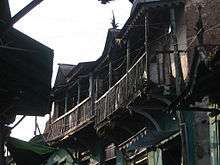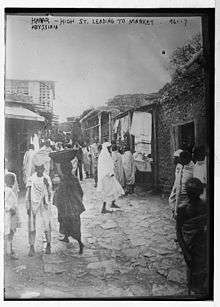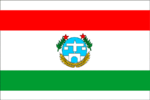Harar
| Harar ሓረር (Amharic) هرر (Arabic) | ||
|---|---|---|
| City | ||
|
Old Harar enclosed within the Jugol (city wall) | ||
| ||
| Nickname(s): City of Saints | ||
 Harar Location within Ethiopia | ||
| Coordinates: 9°19′N 42°7′E / 9.317°N 42.117°E | ||
| Country | Ethiopia | |
| Region | Harari | |
| Zone | Misraq Hararghe | |
| Government | ||
| • President | Murad Abdulhadi | |
| Elevation | 1,885 m (6,184 ft) | |
| Population (2012) | ||
| • Total | 151,977 | |
| Time zone | EAT (UTC+3) | |
| Official name | Harar Jugol, the Fortified Historic Town | |
| Type | Cultural | |
| Criteria | ii, iii, iv, v | |
| Designated | 2006 (30th session) | |
| Reference no. | 1189 | |
| State Party |
| |
| Region | Africa | |
Harar, formerly written Harrar[1][2] and known to its inhabitants as Gey, is a walled city in eastern Ethiopia. It was formerly the capital of Harergey and now the capital of the modern Harari ethno-political division (or kilil) of Ethiopia. The city is located on a hilltop in the eastern extension of the Ethiopian Highlands, about five hundred kilometers from Addis Ababa at an elevation of 1,885 meters. Based on figures from the Central Statistical Agency in 2005, Harar had an estimated total population of 122,000, of whom 60,000 were males and 62,000 were females.[3] According to the census of 1994, on which this estimate is based, the city had a population of 76,378.
For centuries, Harar has been a major commercial centre, linked by the trade routes with the rest of Ethiopia, the entire Horn of Africa, the Arabian Peninsula, and, through its ports, the outside world. Harar Jugol, the old walled city, was included in the World Heritage List in 2006 by UNESCO in recognition of its cultural heritage.[4] It is sometimes known in Arabic as "the City of Saints" ("Madinat al-Awilya"). According to UNESCO, it is "considered 'the fourth holy city' of Islam" with 82 mosques, three of which date from the 10th century and 102 shrines.[5][6]
The Fath Madinat Harar records that the cleric Abadir Umar Ar-Rida and several other religious leaders settled in Harar circa 612H (1216 AD).[7] Harar was later made the new capital of the Adal Sultanate in 1520 by the Sultan Abu Bakr ibn Muhammad.[8] The city saw a political decline during the ensuing Emirate of Harar, only regaining some significance in the Khedivate of Egypt period. During Abyssinian rule, the city decayed while maintaining a certain cultural prestige. Today, it is the seat of the Harari ethno-political division.
History
Called Gey ("the City") by its inhabitants, Harar emerged as the center of Islamic culture and religion in the Horn of Africa during end of the Middle Ages.
According to the Fath Madinat Harar, an unpublished history of the city in the 13th century, the cleric Abadir Umar Ar-Rida, along with several other religious leaders, came from the Arabian Peninsula to settle in Harar circa 612H (1216 AD). Sheikh Ar-Rida is regarded as the saint of Harar,[7] as well as the common ancestor of the Somali Sheekhaal clan.[9]
During the Middle Ages, Harar was part of the Adal Sultanate, becoming its capital in 1520 under Sultan Abu Bakr ibn Muhammad. The sixteenth century was the city's Golden Age. The local culture flourished, and many poets lived and wrote there. It also became known for coffee, weaving, basketry and bookbinding.
From Harar, Ahmad ibn Ibrahim al-Ghazi, also known as "Gurey" and "Gragn" (both meaning "the Left-handed"), launched a war of conquest in the sixteenth century that extended the polity's territory and threatened the existence of the neighboring Christian Ethiopian Empire. His successor, Emir Nur ibn Mujahid, built a protective wall around the city.[10] Four meters in height high with five gates, this structure, called Jugol, is still intact and is a symbol of the town to the inhabitants.

The rulers of Harar also struck its own currency, the earliest possible issues bearing a date that may be read as AH 615 (= AD 1218/19); but definitely by AD 1789 the first coins were issued, and more were issued into the nineteenth century.[11]

Following the death of Emir Nur, Harar began a steady decline in wealth and power. A later ruler, Imam Muhammed Jasa, a kinsman of Ahmad Gragn, yielded to the pressures of increasing Oromo raids and in 1577 abandoned the city, relocating to Aussa and making his brother ruler of Harar. The new base not only failed to provide more security from the Oromos, it attracted the hostile attention of the neighboring Afars who raided caravans travelling between Harar and the coast. The Imams of Aussa declined over the next century while Harar regained its independence under `Ali ibn Da`ud, the founder of a dynasty that ruled the city from 1647 until 1875, when it was conquered by Egypt.[12]
During the period of Egyptian rule (1875-1884), Arthur Rimbaud lived in the city as the local factor of several different commercial companies based in Aden; he returned in 1888 to resume trading in coffee, musk and skins until illness forced him to return to France. A house said to have been his residence is now a museum.[13]
In 1885, Harar regained its independence, but this lasted only two years until 6 January 1887 when the Battle of Chelenqo led to Harar's incorporation into the Emperor Menelik II of Ethiopia's growing Empire based in Shewa.
Harar lost some of its commercial importance with the creation of the Addis Ababa - Djibouti Railway, initially intended to run via the city but diverted north of the mountains between Harar and the Awash River to save money. As a result of this, Dire Dawa was founded in 1902 as New Harar.
.jpg)
Harar was captured by Italian troops under Marshall Rudolfo Graziani during the Second Italo-Abyssinian War on 8 May 1937. The 1st battalion of the Nigeria Regiment, advancing from Jijiga by way of the Marda Pass, captured the city for the allies 29 March 1941.[14] Following the conclusion of the Anglo-Ethiopian Agreement in 1944, the government of the United Kingdom were granted permission to establish a consulate in Harar, although the British refused to reciprocate by allowing an Ethiopian one at Hargeisa. After numerous reports of British activities in the Haud that violated the London Agreement of 1954, the Ethiopian Ministry of Foreign Affairs ordered the consulate closed March 1960.[15]
In 1995, the city and its environs became an Ethiopian region (or kilil) in its own right. A pipeline to carry water to the city from Dire Dawa is currently under construction.
According to Sir Richard Burton Harar is the birthplace of the khat plant.[16] The original domesticated coffee plant is also said to have been from Harar.[17]
Climate
The climate of Harar is classified as subtropical highland climate (Cwb) in Köppen-Geiger climate classification system.
| Climate data for Harar | |||||||||||||
|---|---|---|---|---|---|---|---|---|---|---|---|---|---|
| Month | Jan | Feb | Mar | Apr | May | Jun | Jul | Aug | Sep | Oct | Nov | Dec | Year |
| Average high °C (°F) | 25.3 (77.5) |
26.3 (79.3) |
27.1 (80.8) |
26.9 (80.4) |
27.0 (80.6) |
25.5 (77.9) |
23.8 (74.8) |
22.6 (72.7) |
23.9 (75) |
26.1 (79) |
25.8 (78.4) |
25.8 (78.4) |
25.51 (77.9) |
| Average low °C (°F) | 11.9 (53.4) |
12.9 (55.2) |
13.7 (56.7) |
14.5 (58.1) |
14.6 (58.3) |
14.1 (57.4) |
14.0 (57.2) |
13.6 (56.5) |
13.5 (56.3) |
13.1 (55.6) |
12.1 (53.8) |
12.0 (53.6) |
13.33 (56.01) |
| Average rainfall mm (inches) | 17 (0.67) |
20 (0.79) |
57 (2.24) |
84 (3.31) |
91 (3.58) |
68 (2.68) |
99 (3.9) |
126 (4.96) |
94 (3.7) |
49 (1.93) |
12 (0.47) |
6 (0.24) |
723 (28.47) |
| Source: Climate-Data[18] | |||||||||||||
People

The inhabitants of Harar represent several different Afro-Asiatic-speaking ethnic groups, both Muslim and Christian, including the Oromo, Somali, Amhara, Gurage and Tigray. The Harari, who refer to themselves as Gey 'Usu ("People of the City") are a Semitic-speaking people. Their language, Harari, constitutes a Semitic pocket in a predominantly Cushitic-speaking region. Originally written in the Arabic script, the Harari language has recently converted to the Ge'ez script.
During his visit in the 19th century (1854), Richard F. Burton describes the town as having roughly 8,000 inhabitants with 2,500 of these being Hararis, 2,500 being Somalis and 3,000 being Bedouins who come and go. Though in this case, "Bedouin" is simply a term for nomads in the region whether they were Somalis, Afars or Oromos and doesn't necessarily connote an Arab origin. At this point in time, predating the conquest of Harar by Menelik II, there was no mention of Oromo, Amhara, Tigray-Tigrinya or Gurage residents who are now common in the town whilst Hararis and Somalis who are now minorities looked to be the bulk of the population at the time. [19]
Attractions
Besides the stone wall surrounding the city, the old town is home to 110 mosques and many more shrines, centered on Feres Magala square. Notable buildings include Medhane Alem Cathedral, the house of Ras Mekonnen, the house of Arthur Rimbaud, the sixteenth century Jami Mosque and the historical great five gates of harrer. Harrar Bira Stadium is the home stadium for the Harrar Beer Bottling FC. One can also visit the market.

A long-standing tradition of feeding meat to spotted hyenas also evolved during the 1960s into an impressive night show for tourists.[20] (See spotted hyenas in Harar.)
Other places of interest include the highest amba overlooking the city, the Kondudo or "W" mountain, which hosts an ancient population of feral horses. A 2008 scientific mission has unleashed efforts for their conservation, as the animals are greatly endangered.[21]
The Harar Brewery was established in 1984. Its beers can be sampled at the brewery social club adjacent to the brewery in Harar.[22][23]
Intercity bus service is provided by the Selam Bus Line Share Company.
Sister cities
 Charleville-Mézières, France
Charleville-Mézières, France Clarkston, United States
Clarkston, United States Sanliurfa, Turkey
Sanliurfa, Turkey
Notable residents
- 'Abd Allah II ibn 'Ali 'Abd ash-Shakur, Last Emir of Harar
- Abadir Umar Ar-Rida, Muslim Cleric
- Ahmad ibn Ibrahim al-Ghazi, Leader of the Adal Sultanate
- Nur ibn Mujahid, Emir of Harar
- Abdullah al-Harari, Leader of Ahbash Movement
- Malik Ambar, Leader of Ahmadnagar Sultanate
- `Ali ibn Da`ud, Founder of Emirate of Harar
- Haboba, First Emir of Harar
- Arthur Rimbaud, the French poet, settled as a merchant in Harar between 1880 and 1891
See also
- Harar Brewery
- Harar coffee
- Harari language
- Harari people
- Islam in Ethiopia
- Project Harar
- List of World Heritage Sites in Ethiopia
Notes
- ↑ "Harrar" in the Encyclopædia Britannica, 11th ed. 1911.
- ↑ Other variants include Hārer and Harer.
- ↑ CSA 2005 National Statistics, Table B.4
- ↑ "Panda sanctuary, tequila area join UN World Heritage sites". Un.org. 2006-07-13. Retrieved 2013-07-23.
- ↑ "Harar Jugol, the Fortified Historic Town". World Heritage List. UNESCO World Heritage Centre. Retrieved 6 August 2009.
It is considered 'the fourth holy city' of Islam, having been founded by a holy missionary from the Arabic Peninsula.
- ↑ "Five new heritage sites in Africa". BBC. July 13, 2006. Retrieved 2006-12-18.
Harar Jugol, seen as the fourth holiest city of Islam, includes 82 mosques, three of which date from the 10th Century, and 102 shrines.
- 1 2 Siegbert Uhlig, Encyclopaedia Aethiopica: He-N, Volume 3, (Otto Harrassowitz Verlag: 2007), pp.111 & 319.
- ↑ Richard Pankhurst, History of Ethiopian Towns (Wiesbaden: Franz Steiner Verlag, 1982), p. 49.
- ↑ Burton, Richard (1856). First Footsteps in East Africa. pp. 279–280.
The Shaykhash, or "Reverend" as the term means, are the only Somal of the mountains not derived from Dir and Darud. Claiming descent from the Caliph Abubakr, they assert that ten generations ago, one Ao Khutab bin Fakih Umar crossed over from El Hejaz, and settled in Eastern Africa with his six sons, Umar the greater, Umar the less, two Abdillahs, Ahmed, and lastly Siddik.
- ↑ Dr. Enrico Cerulli, Documenti arabi per la storia dell’Ethiopia, Memoria della Accademia Nazionale dei Lincei, Vol. 4, No. 2, Rome, 1931
- ↑ Richard Pankhurst, An Introduction to the Economic History of Ethiopia (London: Lalibela House, 1961), p. 267.
- ↑ Richard Pankhurst, The Ethiopian Borderlands (Lawrenceville: Red Sea Press, 1997), pp. 375-377
- ↑ Munro-Hay, Ethiopia, the unknown land: a cultural and historical guide (London: I.B. Tauris, 2002), p. 184
- ↑ Anthony Mockler, Haile Selassie's War (New York: Olive Branch, 2003), pp. 145, 367f
- ↑ John Spencer, Ethiopia at Bay: A personal account of the Haile Selassie years (Algonac: Reference Publications, 1984), pp. 282-287
- ↑ Libermn, Mark (2003). "LANGUAGE RELATIONSHIPS: FAMILIES, GRAFTS, PRISONS". Basic Reference (pittsburgh, USA: University Pennsylvania Academics) 28: 217–229. Retrieved 2012-04-27.
- ↑ Wild, Anthony (2003). "Coffee: A dark history". Basic Reference (USA: Fourth Estate) 28: 217–229. Retrieved 2012-04-27.
- ↑ "Climate-Data : Ethiopia". Retrieved 11 July 2013.
- ↑ Burton, Richard F. "First footsteps in East Africa or, an exploration of Harar", 1904. Retrieved on 8 February 2016.
- ↑ "The hyena man of Harar". BBC News. 2002-07-01. Retrieved 2013-07-23.
- ↑ "Wild horses exist in Ethiopia, but face danger of extinction: Exploratory Team". Archived from the original on July 15, 2009.
- ↑ "Embassy staff visits Harar Brewery". Norway.org.et. Retrieved 2013-07-23.
- ↑ EthioNetworks.com. "Harrar Brewery, Ethiopia". Ethiopianrestaurant.com. Retrieved 2013-07-23.
Further reading
- Fritz Stuber, "Harar in Äthiopien - Hoffnungslosigkeit und Chancen der Stadterhaltung" (Harar in Ethiopia - The Hopelessness and Challenge of Urban Preservation), in: Die alte Stadt. Vierteljahreszeitschrift für Stadtgeschichte, Stadtsoziologie, Denkmalpflege und Stadtentwicklung (W. Kohlhammer Stuttgart Berlin Köln), Vol. 28, No. 4, 2001, ISSN 0170–9364, pp. 324–343, 14 ill.
- David Vô Vân, Mohammed Jami Guleid, Harar, a cultural guide, Shama Books, Addis Abeba, 2007, 99 pages
External links
| Wikivoyage has a travel guide for Harar. |
| Wikimedia Commons has media related to Harar. |
- Everything Harar
- Map of Harar (1936)
- List of Emirs of Adal and Harar, Royal ark website
| ||||||||
Coordinates: 9°18′40″N 42°07′40″E / 9.31111°N 42.12778°E
|

